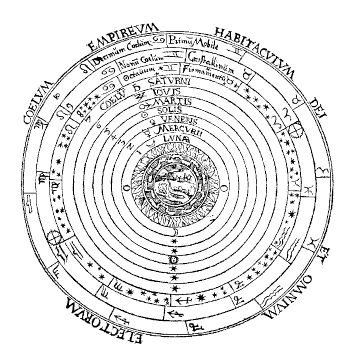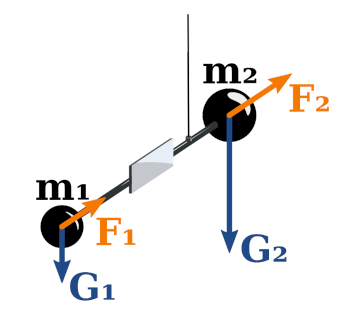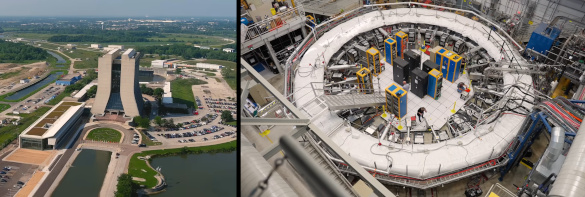Fifth Force
October 2, 2023
Three
physical forces,
gravitation,
electric force, and
magnetism were known to the
ancient Greek philosophers, who could only
conjecture about their origin. I wrote in several previous articles about
Aristotle's idea that
gravity arose from the
principle that
matter sought its proper place, that place being the
center of the universe. According to the
geocentric model of Aristotle's time, the center of the universe was the center of the
Earth.

A model of the geocentric universe.
The geocentric model was adopted by the ancient Greek philosophers as early as the 6th century BC. Aristotle's 4th century BC conception had all the heavenly bodies rotating on transparent, crystalline celestial spheres around a central Earth.
(Wikimedia Commons image. This image appears in Edward Grant, "Celestial Orbs in the Latin Middle Ages", Isis, vol. 78, no. 2. (June, 1987), pp. 152-173. Click for larger image.)
In 1865,
James Clerk Maxwell (1831-1879) reduced the number of known forces from three to two. His
paper in the
Philosophical Transactions of the Royal Society,
A Dynamical Theory of the Electromagnetic Field, established the idea that
light is an
electromagnetic wave, and electricity and magnetism were combined in a single
electromagnetic force.
The development of
nuclear physics resulted in the addition of two other physical forces, the
strong nuclear force, and the
weak nuclear force, which brought the total number of fundamental forces to four. Electromagnetism and the weak nuclear force are actually manifestations of a single force, the so-called
electroweak interaction. Evidence for this was the 1983 discovery of the
W and Z gauge bosons. However, the extreme
temperature at which the electroweak force is evident is so far beyond our present
reality, we still consider that four forces are what
glue the universe together.
What about a
fifth force? Our knowledge of the fundamental forces has been faulty in the past, there being three, then two, and now four. There might be a fifth force lurking somewhere, just out of reach of our
observations. As I wrote in an
earlier article (Fifth Force, September 12, 2016), the idea of a fifth force captured the imagination of
Austro-Hungarian physicist,
Loránd Eötvös (1848-1919), who in 1885-1919 performed a series of
Cavendish balance measurements, now called the
Eötvös experiment. His experiments found no fifth force to a
resolution of 0.05
parts-per-million (ppm) (see figure)

Torsion balance of the original Eötvös experiment. A thin fiber suspends two dissimilar masses at the ends of a rod, and a mirror reflects a beam of light to measure the deflection.
A difference in the ratios of the forces, F1/F2 to that of the gravitational forces, G1/G2, causes a rotation.
In 1889, Eötvös used different materials for the two masses to ascertain the existence of a fifth force. He saw no such change to a measurement precision of 1 in 20 million.
(Wikimedia Commons image by Petteri Aimonen. Click for larger image.)
A group of
physicists reexamined Eötvös'
data in 1986 and found a
correlation of intermediate range force with a
physical property known as
hypercharge.[1-2] The presumed fifth force seemed to operate over a range of tens, to hundreds, of
meters, and not over
cosmological distances where divergence of gravity would have been noted. This observation inspired further
experiments, and the result was not
confirmed, but experiments using force balance techniques continue to the present.[3-5]
The search
trajectory for the fifth force changed in 2016 when a
research team with members from the
University of California - Irvine (Irvine, California) and the
University of Kentucky (Lexington, Kentucky) experimentally detected what looked like a
gauge boson that interacted at an extremely limited range with
electrons and
neutrons, but not
protons.[6-7] What's interesting is the small mass of the
particle, making its study accessible to many
accelerators.[7]
In early August, an international research team working on the
Muon g-2 Experiment at the
Fermi National Accelerator Laboratory (Fermilab) announced their latest results on the
anomalous magnetic moment of the
muon.[8-14] This international team is comprised of nearly 200
scientists from 33
research institutions in seven
countries.[8-9] Muons are
elementary particles with 200 times the mass of an electron, and they have a magnetic moment that causes them to
precess with a value, called
g, that's nearly identical to 2.

Not your 1930's ccyclotron. Left, an aerial view of the Fermi National Accelerator Laboratory (Fermilab). Right, the Muon g-2 Experiment. (Both images are screenshotss of a YouTube video by Fermilab.[14] Click for larger image.)
The deviation from 2 expresses the muon's
interaction with the sea of
virtual particles, the
quantum foam that surrounds it. The experimental value for this precession is 2.00233184110 ± 0.00000000043 (statistical) ± 0.00000000019 (systemic error); or, more succinctly, 2.00233183620(86).[8,10] These results appear in a
paper submitted to
Physical Review Letters. The
Standard Model, which considers interactions with the electromagnetic, weak nuclear and strong nuclear forces, can calculate the muon precession to great accuracy.[9] Experiments have long turned up a precision that's slightly different, but not with enough accuracy to cause any
tension.[10] Any deviation from the
calculated value indicates some new
physics.
The experiment has reached an acceptable precision, and better precision is expected after a compete
analysis of the data, a process that will take about three additional years.[10]. However, the
theory side of things is still lagging; so, an actual determination that there's something beyond the Standard Model will take some time.[10-11] At present, calculations have a much larger value of uncertainty than the experiment.[11,13]
A new force, a fifth force, might be the cause for deviation from the four force Standard Model.[11] If a fifth force is indeed the cause, the discovery would be the biggest scientific breakthrough since
Albert Einstein's theories of
relativity from more than a
century ago.[11] The muon experiment was funded by the
United States Department of Energy, the
National Science Foundation, the
Istituto Nazionale di Fisica Nucleare (Italy), the
Science and Technology Facilities Council (UK), the
Royal Society (UK), the
European Union Horizon 2020 initiative, the
National Natural Science Foundation of China, the
Republic of Korea, and the
German Research Foundation.[9]
References:
- Ephraim Fischbach, Daniel Sudarsky, Aaron Szafer, and Carrick Talmadge, and S.H. Aronson, "Reanalysis of the Eötvös experiment," Phys. Rev. Lett. vol. 56, no. 1 (January 6, 1986), pp. 3-6, DOI:http://dx.doi.org/10.1103/PhysRevLett.56.3.
- L. Bod, E. Fischbach, G. Marx And Maria Náray-Ziegler, "One Hundred Years Of The Eötvös Experiment," Hungarian Academy of Sciences Web Site, August 31, 1990.
- T. A. Wagner, S. Schlamminger, J. H. Gundlach, and E. G. Adelberger, "Torsion-balance tests of the weak equivalence principle," arXiv, July 10, 2016.
- Peiran Yin, Rui Li, Chengjiang Yin, Xiangyu Xu, Xiang Bian, Han Xie1, Chang-Kui Duan, Pu Huang, Jian-hua He, and Jiangfeng Du, "Experiments with levitated force sensor challenge theories of dark energy," Nature Physics, vol. 18 (2022), pp. 1181-1185, DOI: 10.1038/s41567-022-01706-9.
- Bob Yirka, "Extended tests with levitated force sensor fail to find evidence of fifth force," Phys.org, August 26, 2022.
- Jonathan L. Feng, Bartosz Fornal, Iftah Galon, Susan Gardner, Jordan Smolinsky, Tim M. P. Tait, and Philip Tanedo, "Protophobic Fifth-Force Interpretation of the Observed Anomaly in 8Be Nuclear Transitions," Phys. Rev. Lett., vol. 117, no. 7 (August 12. 2016), Article No. 071803. A version of this paper can be found at arXiv.
- UCI physicists confirm possible discovery of fifth force of nature, University of California, Irvine, Press Release, August 15, 2016.
- D. P. Aguillard, et al., "Measurement of the Positive Muon Anomalous Magnetic Moment to 0.20 ppm," preprint submitted for publication in Physical Review Letters at the g-2 website at Fermilab.
- Muon g-2 doubles down with latest measurement, explores uncharted territory in search of new physics, Fermilab press release, August 10, 2023.
- Katherine Wright, "Mismatch with Standard-Model Predictions Reaches 5 Sigma," Physics, vol. 16, no. 139 (August 10, 2023).
- Pallab Ghosh, "Scientists at Fermilab close in on fifth force of nature, BBC News, August 10, 2023.
- Nicola Davis, "Scientists may be on brink of discovering fifth force of nature," The Guardian (UK), August 11, 2023.
- Ben Turner, "Wobbling muon experiment could reveal a 5th force of nature - if the results hold up," Live Science, August 11, 2023.
- Muon g-2 experiment returns with new precision measurement, Fermilab YouTube video, August 10, 2023.
Linked Keywords: Fundamental interaction; physical force; gravity; gravitation; electrostatics; electric force; magnetism; ancient Greek philosophy; ancient Greek philosophers; conjecture; Aristotle; gravity; physical law; principle; matter; center of the universe; geocentric model; Earth; 6th century BC; 4th century BC; astronomical object; heavenly body; rotation; rotating; transparent; crystal; crystalline; celestial sphere; Wikimedia Commons; Edward Grant, "Celestial Orbs in the Latin Middle Ages"; James Clerk Maxwell (1831-1879); scientific literature; paper; Philosophical Transactions of the Royal Society; A Dynamical Theory of the Electromagnetic Field; light; electromagnetic radiation; electromagnetic wave; electromagnetism; electromagnetic force; nuclear physics; strong nuclear force; weak interaction; weak nuclear force; electroweak interaction; W and Z bosons; gauge boson; temperature; reality; adhesive; glue; fifth force; observation in science; Austria-Hungary; Austro-Hungarian; physicist; Loránd Eötvös (1848-1919); Cavendish balance; Eötvös experiment; resolution; parts-per notation; parts-per-million; torsion balance of the original Eötvös experiment; fiber; mass; rod (geometry); mirror; reflection (physics); reflect; beam of light; measurement; measure; deflection (physics); ratio; force; material; precision; Petteri Aimonen; data; correlation; physical property; hypercharge; meter; cosmology; cosmological; experiment; reproducibility; confirm; trajectory; research; University of California - Irvine (Irvine, California); University of Kentucky (Lexington, Kentucky); electron; neutron; proton; elementary particle; particle accelerator; Muon g-2 experiment; Fermi National Accelerator Laboratory (Fermilab); anomaly (natural sciences); anomalous; magnetic moment; muon; scientist; research institution; country; precession; precess; gyromagnetic ratio; g; cyclotron; aerial photography; aerial view; screenshot; YouTube video by Fermilab; interaction; virtual particle; quantum foam; scientific literature; paper; Physical Review Letters; Standard Model; tension; calculation; calculated; physics; data analysis; scientific theory; Albert Einstein; theory of relativity; century; United States Department of Energy; National Science Foundation; Istituto Nazionale di Fisica Nucleare (Italy); Science and Technology Facilities Council (UK); Royal Society (UK); European Union Horizon 2020 initiative; National Natural Science Foundation of China">National Natural Science Foundation of China; Republic of Korea; German Research Foundation.